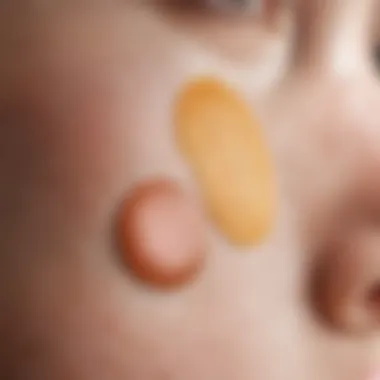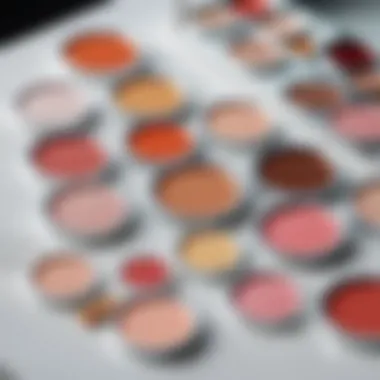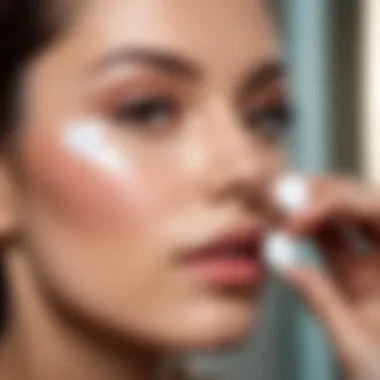Mastering the Art of Cosmetic Patch Application


Intro
In the modern world, cosmetic patches have gained popularity as a convenient solution for various skin concerns. Whether it's addressing dryness, blemishes, or aging, understanding how to apply these patches correctly can enhance their effectiveness and contribute to overall skin health. This article aims to guide readers through the process of applying cosmetic patches, reviewing essential topics such as the different types of patches, best practices for their application, and post-application care.
Effective usage of cosmetic patches relies on proper technique and awareness of skin types. The following sections will expand upon these key points to enable a comprehensive understanding of this trending beauty method.
Популярные акции и предложения
Current offers in the realm of cosmetic products can significantly influence purchasing decisions. Staying informed about ongoing discounts and promotional events is beneficial for consumers seeking effective solutions for their skincare needs.
- Обзор текущих скидок на косметические бренды
Various brands often provide discounts on their products. Keeping an eye on the official websites or online retailers can help identify significant savings. - Сезонные распродажи и специальные предложения
Seasonal sales present excellent opportunities to acquire premium cosmetic patches at reduced prices. Events such as Black Friday, end-of-season sales, or holiday promotions might feature worthwhile deals.
Рекомендации по выбору косметики
Choosing the right cosmetic patch involves understanding individual skin requirements and conditions. Selecting the most suitable product can enhance efficacy and overall satisfaction.
- Как выбрать косметические средства по типу кожи
Each skin type—be it oily, dry, or combination—requires specific patch ingredients. Those with oily skin might benefit from patches containing salicylic acid, while hydrating patches suit dry skin better. - Советы по выбору косметики для разных возрастных групп
The choice of cosmetic patches can also vary by age group. Younger individuals may seek out patches focused on blemish control, whereas more mature skin may call for hydrating and anti-aging patches.
With this foundational knowledge, the subsequent sections will delve deeper into the methodology behind the application of cosmetic patches, ensuring a well-rounded understanding of their effective use.
Understanding Cosmetic Patches
In the realm of skincare, cosmetic patches represent a unique and effective approach to addressing various skin concerns. Understanding what they are and how they function is crucial for anyone seeking to enhance their skincare routine. Cosmetic patches apply active ingredients directly to specific areas of the skin, promoting targeted treatment.
The significance of this topic extends beyond basic understanding. It encompasses the wisdom of making informed choices regarding skin health and care. With numerous options available in today’s market, knowing the differences can lead to tailored solutions that better match individual needs. Moreover, comprehending the purpose behind each type of patch empowers users to maximize their efficacy.
Definition of Cosmetic Patches
Cosmetic patches are adhesive products applied to the skin, often embedded with beneficial ingredients. They serve to deliver hydration, anti-aging compounds, or targeted treatments directly to the surface. Typically, they are used on the face or other body areas where specific results are desired. By adhering closely to the skin, these patches create a conducive environment for absorption, allowing active ingredients to penetrate more effectively compared to traditional creams or serums.
Types of Cosmetic Patches
Understanding the different types of cosmetic patches is essential for effective application and desired results. Each variety offers its own benefits and is suited for different purposes.
Hydrogel patches
Hydrogel patches are gaining popularity for their ability to deliver intense hydration. These patches contain water-based gel formulations that help in providing moisture to the skin. A key characteristic of hydrogel patches is their cooling effect upon application. This can soothe and refresh the skin, making them an excellent choice especially for those with tired or puffy areas. A unique feature is their high water content, which can enhance the absorption of active ingredients. However, while they are beneficial for hydration, they may not adhere as firmly as other options, leading to potential dislodgment during use.
Fabric patches
Fabric patches are made from a thin layer of fabric that usually absorbs and delivers serum to the skin. The key characteristic is their flexibility, allowing them to conform easily to the face’s features. Fabric patches are particularly beneficial for extended wear; they tend to stick well and can maintain contact with the skin over longer periods. Their unique feature is the infusion of various serums infused in the fabric itself, which ensures that the nourishment reaches different layers of skin. However, some users may find them cumbersome to apply, especially if they do not fit perfectly.
Gel patches
Gel patches often come in a flexible gel form that clings well to the skin. A distinguishing characteristic is their thickness, providing a substantial barrier that locks in moisture and keeps the active ingredients from evaporating. Gel patches are especially effective for reducing the appearance of fine lines and dryness. One advantage is their ease of application and secure adhesion. However, they may be less comfortable for prolonged wear.
Medicated patches
Medicated patches are designed to deliver specific treatments, often containing active pharmaceutical ingredients aimed at treating conditions such as acne or experiencing irritation. The key characteristic of these patches is their therapeutic nature. They can target skin issues with precision, making them a popular choice for individuals dealing with specific skin concerns. Their unique feature lies in the ability to provide continuous medication, which is a significant advantage over traditional topical treatments. On the downside, they may require careful selection to avoid potential adverse reactions, especially for sensitive skin.
Purpose of Using Cosmetic Patches
The purpose of cosmetic patches spans various goals, including hydration, wrinkle reduction, targeted treatment, and brightening.


Hydration
Hydration is one of the primary functions of cosmetic patches. These patches deliver intense moisture to the skin, resulting in both immediate and long-lasting effects. The absorbing ingredients such as hyaluronic acid are often used, making them popular among those with dry skin. A unique aspect of these patches is their ability to provide a quick boost of hydration, which is especially desirable before special events or during seasonal changes when skin tends to become drier. However, reliance solely on patches may not fully replace a comprehensive skincare routine.
Wrinkle reduction
Wrinkle reduction is a key purpose of many cosmetic patches. Users can apply these patches to specific areas prone to fine lines, such as under the eyes. Their characteristic is the infusion of active compounds that promote collagen production and skin elasticity. By targeting wrinkles, these patches become a beneficial tool for those looking to age gracefully. The unique aspect is the mechanical compression method they utilize, which can smoothen the skin temporarily. Nonetheless, results may vary and be more effective as part of a broader anti-aging regimen.
Targeted treatment
Targeted treatment is another significant aim of cosmetic patches. Users can directly address specific skin issues, such as blemishes or dark spots. The main advantage is their precision, allowing for effective intervention on a localized area without affecting surrounding skin. In terms of characteristics, these patches often feature active ingredients tailored for particular skin concerns, ensuring that the treatment is effective. However, users must exercise caution and ideally consult dermatologists to avoid adverse reactions, especially for sensitive skin types.
Brightening
Brightening patches aim to enhance skin radiance and reduce the appearance of dullness. The active ingredients often include vitamin C or niacinamide, which are known for their skin-brightening properties. A key aspect of these patches is the quick delivery system they provide, allowing users to see immediate effects. Unique to brightening patches, their formulation can help with uneven skin tone, addressing both temporary and chronic issues. Yet, the results may not be deeply lasting, and continuous use in conjunction with a proper skincare routine is recommended.
Preparing for Application
Preparing for the application of cosmetic patches is a critical step that can significantly impact the effectiveness of the product. The success of cosmetic patches hinges on proper skin care techniques. In this section, we will explore skin preparation steps and key considerations for selecting the most suitable patch for your needs.
Skin Preparation Steps
Removing makeup
Removing makeup is an essential first step. It ensures that the skin is free from any barriers that might hinder the patch's contact with the skin. A clean surface is necessary for the active ingredients in the patch to penetrate effectively. Notably, using a gentle makeup remover is beneficial. This minimizes skin irritation and is suitable for all skin types.
A common practice is to use micellar water or oil-based removers, as they efficiently dissolve makeup without harsh scrubbing. By removing makeup, you allow the skin to breathe and absorb the beneficial components from the patch effectively.
Cleansing the skin
Cleansing the skin following makeup removal is critical to ensure the surface is not just clear of makeup but also free from dirt and oils. A thorough cleanse helps prepare the skin to receive the patch optimally. Choosing a product that suits your skin type, whether it is gel-based for oily skin or cream-based for dry skin, enhances the cleansing process.
Unique cleansers can sometimes leave a residue that may interfere with the adhesive properties of patches. Therefore, using a pH-balanced cleanser is advisable to prevent any skin disruptions. A well-cleansed face sets a solid foundation for patch application.
Exfoliation
Exfoliation, while not mandatory before every application, plays a significant role in skin prep for those seeking maximum benefit from their cosmetic patches. This process sloughs off dead skin cells, allowing for better absorption of active ingredients. It promotes smoother skin texture, which is also beneficial when applying the patches.
However, one must be cautious. Over-exfoliating can lead to irritation, particularly in sensitive skin types. Exfoliation should be adapted to individual skin needs. A gentle tool or product, like a mild chemical exfoliant, offers a balanced approach. An optimal exfoliation process enhances the effectiveness of the patches, leading to improved results.
Choosing the Right Patch
Making the right choices in selecting the correct cosmetic patch aligns with the success of your skincare routine. Different patches serve varied purposes, and understanding both your skin type and the specific intentions of the patch is crucial.
Skin type considerations
Skin type considerations are essential when selecting the right patch. Each patch may be designed with specific skin types in mind, such as oily, dry, or sensitive skin. Using a patch that aligns with your skin type ensures that the treatment is effective while minimizing the risk of irritation.
For example, hydrogel patches often benefit dehydrated skin, while fabric patches might suit those looking for targeted treatment. Understanding your skin type helps in making an informed decision that promotes both efficacy and overall skin health.
Patch purpose alignment
Patch purpose alignment is likewise significant. It refers to the specific goals you hope to achieve with the use of the patch; whether that is hydration, wrinkle reduction, or treatment of particular issues like dark spots. Each patch offers unique active ingredients designed for particular outcomes.
Choosing a product that matches your needs not only ensures that the patch will address your concerns but also maximizes the potential for desired results. Aligning your patch choice with your skincare goals enhances the chances of seeing noticeable improvement.


Application Techniques
Understanding the right application techniques is crucial for achieving the maximum effectiveness of cosmetic patches. Proper application not only ensures the active ingredients penetrate the skin effectively but also enhances overall comfort during wear. Emphasizing application techniques can prevent common mistakes that undermine intended results. Therefore, this section details essential application guidelines and provides specific instructions tailored to various types of patches.
Timing and Duration
Understanding the timing and duration of applying cosmetic patches is crucial to maximizing their effectiveness. Each type of patch is designed with specific active ingredients that work best within a certain time frame. Knowing how long to leave a patch on and the ideal timing for its application can enhance results, prevent skin irritation, and ensure the benefits are realized.
Furthermore, improper timing can lead to diminished efficacy or adverse reactions. Thus, this section will offer clear guidance on recommended durations for different patch types and factors that may influence these durations.
Recommended Duration for Each Patch Type
Different cosmetic patches come with varying recommendations for duration. Generally, here are the usual guidelines:
- Hydrogel patches: Best kept on for 20-30 minutes. Their gel-like feature allows ingredients to penetrate the skin effectively during this time.
- Fabric patches: These can remain on the skin for 30 minutes to 12 hours, depending on the intended effects and the specific formulation used.
- Gel patches: Generally, these patches are designed for either short periods, like 15-30 minutes, or longer applications of several hours, depending on the formulation.
- Medicated patches: These often have a recommended duration of 8-12 hours, as they are engineered to deliver active ingredients at a controlled rate.
Factors Influencing Duration
Skin Sensitivity
Skin sensitivity is a key factor in determining how long to keep a patch on. Sensitive skin often reacts differently compared to normal skin. It may redden or feel irritated with prolonged exposure to certain ingredients.
The unique characteristic of sensitive skin is its lower tolerance to active compounds. This trait makes it essential to monitor comfort levels during application. For individuals with sensitive skin, shorter application periods may be beneficial. They should start with a patch application of around 10-15 minutes to see how their skin reacts before increasing the duration gradually. This cautious approach allows users to enjoy the benefits without risking irritation.
Environmental Factors
Environmental factors also play a role in determining how long a patch should be used. Factors such as humidity, temperature, and exposure to pollutants can affect skin absorption and the patch's stability.
A significant characteristic is that higher humidity can enhance ingredient absorption, potentially allowing shorter application times without compromising efficacy. Conversely, in dry or polluted environments, users may find that patches take longer to work effectively. This may require them to keep the patches on for the recommended maximum duration to achieve desired results. These considerations are important to enhance the proposed benefits while ensuring skin health remains a priority.
"Proper timing and understanding your skin needs can amplify the effectiveness of cosmetic patches while protecting skin integrity."
In summary, being mindful of the various types of patches and adhering to recommended durations while accounting for skin sensitivity and environmental factors is essential. This will enhance overall effectiveness and user experience.
Post-Application Care
Post-application care is essential for maximizing the benefits of cosmetic patches. Proper care after removing a patch can enhance efficacy and promote optimal skin health. Understanding what to do after application informs users how to maintain the advantages gained. This section covers critical aspects related to removing the patch and the recommended steps to take post-application.
Removing the Patch
The removal of the patch requires caution to avoid any redness or irritation to the skin. Start with clean hands to prevent any contaminants from affecting the skin. It is best to gently peel back one edge of the patch and slowly lift it away from the skin. Avoid pulling it abruptly as that can cause unnecessary discomfort. If there is any residue left behind, it can be removed with a gentle cleanser or a cotton pad soaked in micellar water. This step ensures that the skin returns to its normal state without leftover adhesive.
Aftercare Recommendations
Moisturizing
Moisturizing after using cosmetic patches can play a pivotal role in ensuring lasting skin hydration. This step helps to seal in the benefits derived from the patch while providing additional nourishment to the skin. A well-chosen moisturizer can replenish moisture levels that may have fluctuated during the patch's application.
Key characteristics of moisturizing are its ability to hydrate and soothe the skin effectively. Since many patches deliver concentrated ingredients, the skin might feel a bit dry after removing them. Hence, applying a moisturizer matches the skin’s needs and can enhance its feel overall.
Among the advantages of moisturizing is the additional layer of protection it offers against environmental elements. This contributes to the skin barrier that might have been compromised during the patch use. However, it is also important to select a suitable product that aligns with one’s skin type to avoid potential breakouts or irritation.
Monitoring for Irritation
Monitoring for irritation plays an important role post-application. After removing a patch, keeping an eye on the skin can help identify any adverse reactions early. It is vital to look for any signs such as redness, itching, or excessive dryness. This attentiveness ensures that skin health is prioritized.


The emphasis of monitoring is on recognizing any discomfort that may arise. Prompt action can help in dealing with issues before they escalate. If irritation occurs, using calming products designed to alleviate such symptoms can be beneficial.
The unique feature of monitoring is that it fosters a proactive approach to skin care. This not only aids in quick recovery but also educates on how different products react with skin over time. Thus, it allows an informed decision in future cosmetic patch use.
Common Mistakes to Avoid
Understanding the common mistakes people make when applying cosmetic patches is crucial for achieving optimal results. Many users overlook important steps or misapply patches, leading to ineffective outcomes. Addressing these mistakes can enhance the benefits of the patches, ensuring that users meet their skincare goals effectively. Moreover, being aware of these common pitfalls can improve one's overall skincare routine, contributing to healthier skin in the long run.
Incorrect Skin Preparation
One of the most significant errors in using cosmetic patches is improper skin preparation. The skin needs to be clean and free from impurities for the patches to adhere correctly. Failing to remove makeup or cleanse the skin thoroughly can create a barrier between the patch and the skin, reducing the product's effectiveness.
To prepare the skin adequately:
- Remove any makeup thoroughly. Use a gentle makeup remover or cleansing oil to ensure no residue remains.
- Cleanse the skin with a suitable facial cleanser. It will help to remove any remaining dirt or oils.
- Exfoliate regularly, but not right before applying a patch, as it may cause irritation. Instead, incorporate this step into your routine a few times a week.
Ignoring these steps may prevent the active ingredients in the patches from penetrating the skin effectively. Users will not see the desired results if the skin is not in optimal condition.
Ignoring Patch Timing
Timing plays a crucial role in the effectiveness of cosmetic patches. Each type of patch comes with recommended usage duration, which should not be ignored. Using a patch for too long or not long enough can impact its efficacy. For instance, some patches may work best when used for 15 minutes, while others are designed for overnight wear.
- Follow package instructions carefully. Each product is formulated to perform best within specified time frames.
- Consider your skin type. If your skin is sensitive, shorter application times may be wise to prevent irritation.
- Take environmental factors into account. Humidity or heat can affect how patches perform and their adhesion quality.
By strictly adhering to timing recommendations, users can maximize the benefits of their cosmetic patches and ensure they achieve intended outcomes.
Neglecting Aftercare
Aftercare is often overlooked when it comes to using cosmetic patches, yet it is an integral part of the process. After removing the patch, it is essential to nourish the skin to maintain hydration and promote recovery. Skipping this step can lead to dryness, irritation, or even breakouts.
Recommendations for aftercare include:
- Moisturizing the skin post-application. Use a gentle moisturizer to lock in hydration.
- Monitoring for irritation. After removal, observe the skin for any signs of redness or discomfort. If irritation occurs, discontinue use and consult a dermatologist.
Effective aftercare not only helps in achieving better results from patches used but also enhances overall skin health.
"Proper aftercare routines can significantly improve both the immediate and long-term effects of cosmetic treatments."
By avoiding these common mistakes, users can ensure that their experience with cosmetic patches is positive, yielding the desired benefits.
Evaluating Patch Effectiveness
Evaluating the effectiveness of cosmetic patches is crucial for users aiming to achieve their skin care goals. This section highlights the importance of understanding how well a patch delivers its promised benefits. Users should be equipped to judge not only visible results but also overall skin comfort during and after use. Awareness in these areas can enhance the user experience and ensure informed choices regarding cosmetic products.
Indicators of Success
Visible results
Visible results refer to the noticeable improvements in the skin after using cosmetic patches. This aspect is central to determining whether the patch fulfills its intended purpose. One key characteristic of visible results is their direct correlation with the effectiveness of the ingredients used in the patch. When users see positive changes, like diminished fine lines or improved hydration, it confirms the patch is working.
The unique feature of visible results is their immediate impact on a user’s confidence. Experiencing visible improvements can often encourage consistent use of patches, leading to more sustained skin benefits. However, one potential disadvantage may arise if results are not immediate; users may become disheartened and give up on the product too soon. Hence, it's vital to remember that some results take time and regular application to manifest fully.
Skin comfort levels
Skin comfort levels reflect how pleasant a patch feels during application and after removal. This aspect contributes significantly to the overall experience of using cosmetic patches. A key characteristic of skin comfort is the fit and adherence of the patch to the skin. Patches that maintain their position without causing irritation tend to enhance user satisfaction.
The unique feature of skin comfort levels is that they can vary significantly among different types of patches. Some users may find hydrogel patches soothing, while others might prefer fabric-based options. It is crucial to recognize personal preferences, as discomfort can lead to negative associations with the product. On the other hand, an uncomfortable experience could discourage someone from exploring other beneficial options.
When to Seek Professional Advice
Knowing when to seek professional advice is essential when evaluating the effectiveness of cosmetic patches. If users notice adverse reactions, prolonged irritation, or lack of expected results, consulting a skin care professional can provide valuable guidance. A professional can assess individual skin needs and recommend suitable products or alternative methods. Ignoring persistent issues can lead to further skin complications and hinder desired results.















